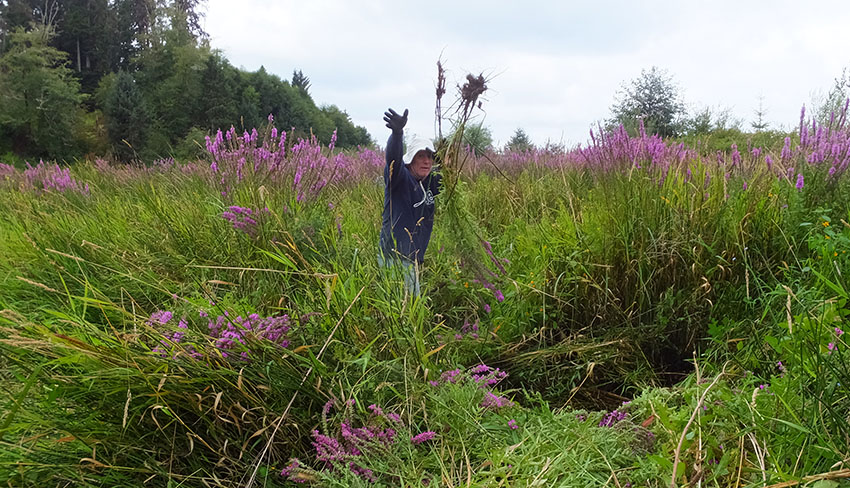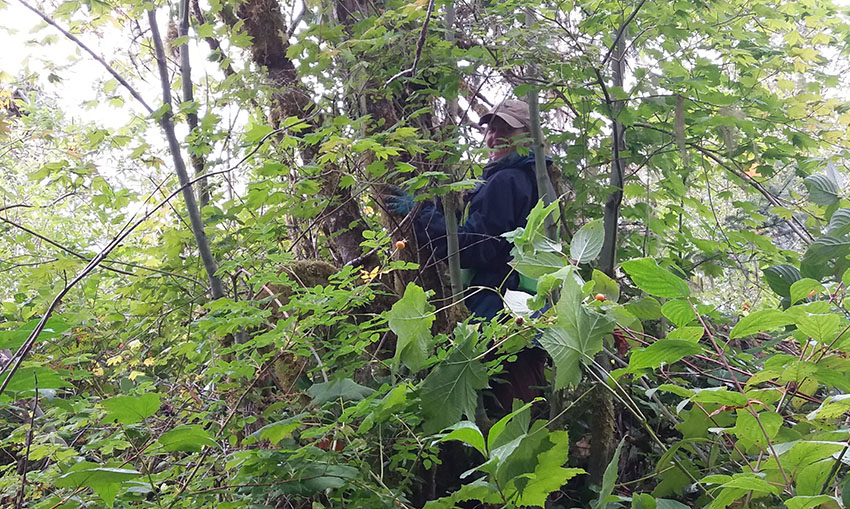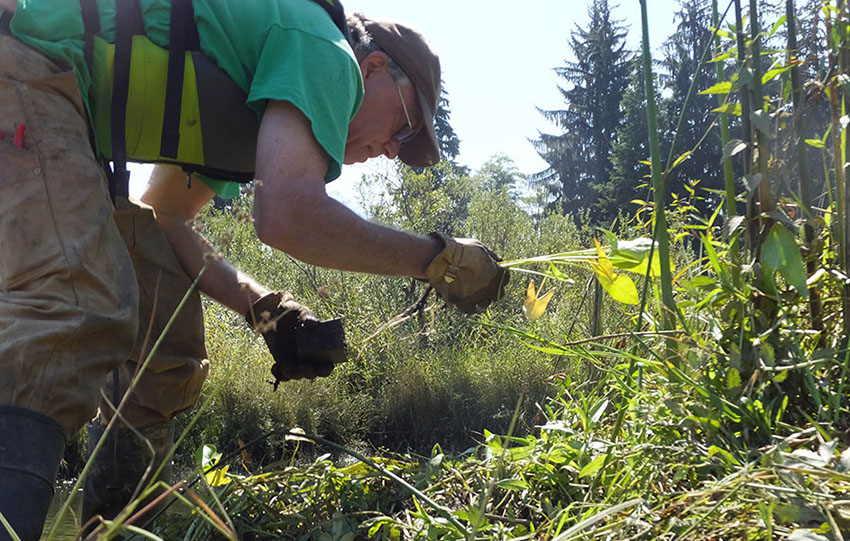
Thanks to volunteer James Thompson for coining the name Swampathon (and penning the welcome sign!).
Once a year a dozen or so staff and volunteers from North Coast Land Conservancy and The Nature Conservancy’s Oregon office get together for a weekend of weed-pulling at their nearly neighboring preserves on the lower Columbia River: Blind Slough Swamp Preserve (TNC) and Wolf Bay Habitat Reserve (NCLC). This August they upped the ante, adding a day of botanizing by canoe with members of the Filipendula Chapter of the Native Plant Society and a day of planting native species in nearby John Day Marsh Habitat Reserve—also via canoe. And Swampathon 2018 was born.
Sounds like a party, but one volunteer characterized her day of pulling well-established loosestrife in Wolf Bay her gnarliest stewardship gig to date. Swampathon was actually the Year One centerpiece of a two-year marsh restoration project NCLC is conducting in both Wolf Bay and John Day Marsh habitat reserves on the lower Columbia, funded in part by the Oregon Watershed Enhancement Board. The idea was to spend not just a day or two but the better part of a month making a serious dent in the invasive purple loosestrife found widely in the marshes here. (OWEB funding allowed NCLC to give its summer stewardship interns an extra month of work in the marsh.) Loosestrife edges out native vegetation that wildlife needs, and its dense root systems can build up the level of soil and utterly change the character of the marsh. The project also targeted yellow flag iris and English ivy, two other invasive plants found along the lower Columbia. The Swampathon team not only removed undesirable plants but planted coastal marsh natives such as red osier dogwood, wapato, and Henderson’s checkermallow.
Here is a glimpse of Swampathon 2018. You’ll find more information and photos in an article titled “Purple Reign” that ran in the Daily Astorian. Thanks to the extremely hardworking volunteers who paddled canoes, slid along slippery mudbanks, and sloshed through tidal marshes to dig, hack, and haul weeds as well as transporting and planting hundreds of native plants now growing in John Day Marsh Habitat Reserve. Our interns finished out the month with more marsh planting and weeding, and we’ll be back in the spring to plant more wapato, tule and other natives at Wolf Bay.

SATURDAY: Land Steward Eric Owen orients volunteers to the task ahead.

After and before: The un-purple part of the marsh is the result of much weed-pulling by NCLC’s summer interns.

Vaughn piles purple loosestrife. Volunteers worked on the south side of the property, where they encountered especially large, well-established loosestrife.

Tom gives a loosestrife plant the heave-ho.

Penny heads up the hill, burdened by a large pile of uprooted loosestrife.

And right behind Penny is Pat with more loosestrife.

Saturday’s team. After uprooting the loosestrife,volunteers carried to high ground and left it out to dessicate.

SUNDAY: Loosestrife weeding in Blind Slough Swamp required canoes. Debbie has slithered up a muddy bank to grab some weeds.

Debbie and Dave cross Blind Slough’s Warren Inlet in search of more loosestrife.

Molly holds the canoe in the current as Jeff returns with more loosestrife.

That’s Project Manager Amy Hutmacher, halfway up a tree, in pursuit of ivy. While four volunteers in two canoes hunted down loosestrife in inlets off Blind Slough, another 12 people also traveling by canoe managed to cut and tear away ivy from 47 trees in the swamp.

MONDAY: Justin tosses Eric a plug of native tule.

James plants wapato on a rise in John Day River Marsh. He put in more hours than any other volunteer, including picking up our plants in Longview and hauling them to the marsh. Thank you, James!

Summer intern Stephanie Mendez-Garcia with Pacific silverweed

Stewardship Director Melissa Reich paddles back to the landing after a morning of planting in John Day River Marsh, at right.
Comments